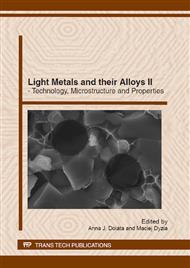p.81
p.89
p.101
p.109
p.115
p.123
p.131
p.137
p.145
Influence of Mould Cooling Rate on the Microstructure of AZ91 Magnesium Alloy Castings
Abstract:
Magnesium alloys are the lightest, widely used structural material. They are often used in aeronautical and automotive industries, where the weight savings are essential. Due to high responsibility of the elements made from magnesium alloys it is important to achieve high quality castings without any defects. The paper presents results of investigations on impact of sand mould cooling rate on microstructure and quality of the castings. Six identical castings, fed and cooled in different ways were investigated. Studies consisted of: RTG investigations and SEM and LM observations. Microstructure was evaluated qualitatively and quantitatively. RTG investigations showed that casting without feeder and cooler, casting only with feeder and castings cooled with 20mm and 40mm thick cooler contains voids inside. Castings with feeder and coolers 20mm and 400mm thick were flawless. Microstructure evaluation showed that castings with and without defects have different structure. Castings with defects were characterized by higher volume fraction of Mg17Al12 intermetallic phase. Flawless castings were characterized by fully divorced eutectic.
Info:
Periodical:
Pages:
115-122
Citation:
Online since:
August 2012
Authors:
Price:
Сopyright:
© 2012 Trans Tech Publications Ltd. All Rights Reserved
Share:
Citation:


